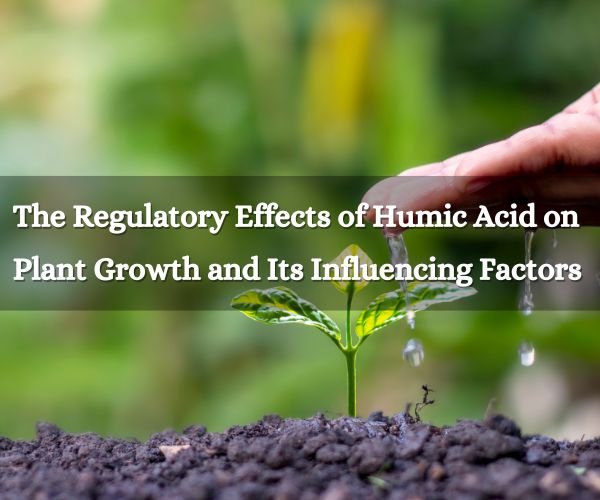Humic acid, a naturally occurring organic compound, is a major component of soil organic matter. It plays a vital role in improving soil fertility, promoting plant growth, and enhancing crop productivity. With increasing attention to sustainable agriculture and eco-friendly farming practices, humic acid has gained significant importance in modern agricultural production.
1. Key Benefits of Humic Acid in Plant Growth
1.1 Promotes Root Development
Humic acid is widely recognized as a natural root growth stimulator. It enhances root length, branching, and root hair density, leading to a larger root surface area and improved nutrient uptake. One of the key mechanisms is the activation of plasma membrane H+-ATPase, which promotes proton efflux, increases rhizosphere acidification, and stimulates root formation and elongation.
1.2 Humic Acid Enhances Nutrient Uptake
By improving membrane permeability and modifying the electrochemical gradient across cell membranes, humic acid increases the absorption efficiency of essential nutrients such as nitrogen (N), phosphorus (P), potassium (K), calcium (Ca), and magnesium (Mg). For example, in crops like sweet potato, humic acid significantly enhances potassium uptake during early growth stages.
1.3 Regulates Carbon and Nitrogen Metabolism
Humic acid affects key enzymes involved in carbon fixation and nitrogen assimilation, including RuBisCO, ADP-glucose pyrophosphorylase, and NADP-GAPDH. It also positively regulates enzymes such as nitrate reductase and glutamine synthetase, thus improving photosynthesis, sugar accumulation, and overall nitrogen use efficiency in plants.
1.4 Improves Plant Stress Resistance
It can help plants cope with nutrient deficiency stress, especially under low nitrate conditions, by optimizing nitrogen metabolism and reducing nitrogen loss. It also regulates stress-related gene expression, delays leaf senescence, and enhances plant resilience under adverse environmental conditions.
1.5 Humic Acid Stimulates Seed Germination
Seed treatment with humic acid has been shown to improve germination rate, seedling vigor, and biomass accumulation. The bioactivity is linked to its molecular structure, particularly the presence of amphiphilic molecules that stimulate early-stage development.
2. Key Factors Influencing the Effectiveness of Humic Acid
2.1 Application Rate
The dosage of humic acid greatly influences its effectiveness. While moderate application typically enhances growth and yield, excessive amounts may lead to diminishing returns or even negative effects. For example, wheat shows yield improvement with 30 kg/hm² of humic acid, but the benefit decreases when the rate exceeds 90 kg/hm².
2.2 Application Timing
Timing of application is crucial. Applying during the early seedling stage may interfere with photosynthesis and chlorophyll synthesis, whereas application during active growth stages improves leaf chlorophyll content, photosynthetic rate, and biomass accumulation.
2.3 Hormonal Components
It contains hormone-like substances, such as auxins, that mimic plant growth regulators. These compounds promote root elongation and nutrient uptake. Studies have shown it upregulates genes related to H+-ATPase activity, supporting its hormone-like behavior.
2.4 Molecular Structure
The molecular weight and composition affect its biological activity. Low-molecular-weight humic acids with high aromatic content and carboxyl group density tend to be more effective in stimulating root activity, nutrient absorption, and enzyme function. Water-soluble and highly hydrophobic structures are especially active.
3. Future Research and Application Perspectives
To further harness the full potential of humic acid in agriculture, future research should focus on:
- Investigating the effects of humic acid across different crop species, growth stages, and environmental conditions for tailored application strategies.
- Exploring the synergistic effects of humic acid with other biostimulants or fertilizers to maximize plant performance.
- Decoding the signaling pathways and gene expression mechanisms involved in humic acid action to identify key molecular targets.
- Evaluating the role of humic acid in enhancing disease resistance and abiotic stress tolerance, offering eco-friendly plant protection alternatives.
- Studying long-term effects of humic acid on soil health, crop yield, and environmental sustainability under field conditions.
- Developing optimized application protocols that balance economic benefits and ecological safety, supporting green agriculture development.
Humic acid is a powerful natural biostimulant with multifaceted benefits for plant growth, stress tolerance, and nutrient efficiency. However, its effects are influenced by various factors such as dosage, timing, and molecular characteristics. A better understanding and application can significantly contribute to sustainable agriculture, improve soil health, and support high-quality crop production.
At WELLYOU TECH, we are committed to offering advanced humic acid-based solutions tailored to modern agricultural needs. Contact us to explore how our products can help you achieve healthier crops and better yields.


